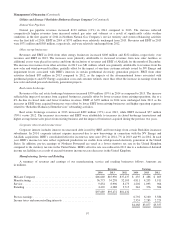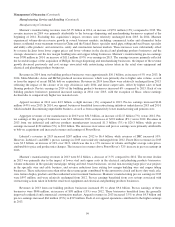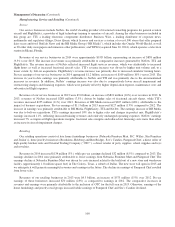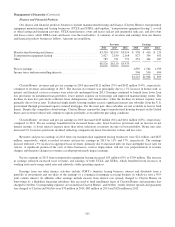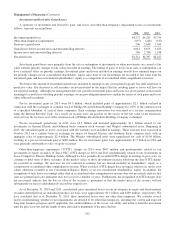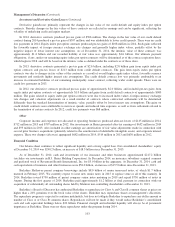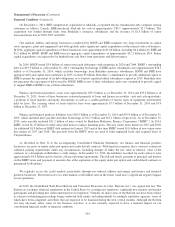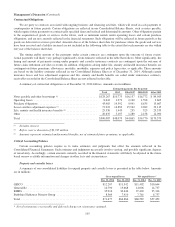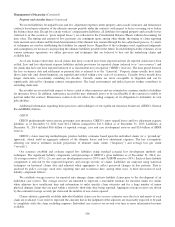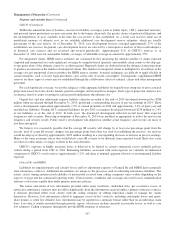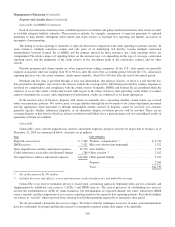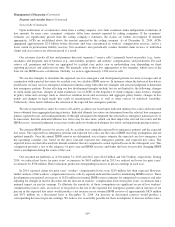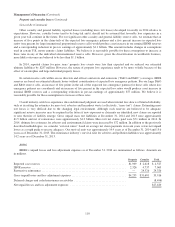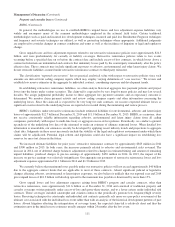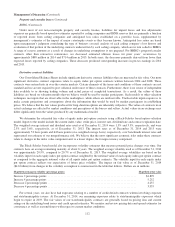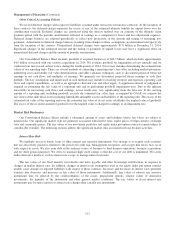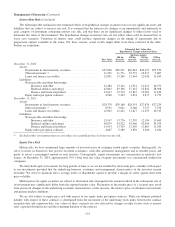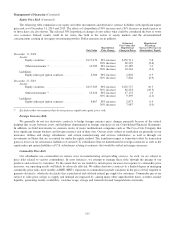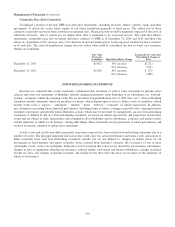Berkshire Hathaway 2014 Annual Report Download - page 108
Download and view the complete annual report
Please find page 108 of the 2014 Berkshire Hathaway annual report below. You can navigate through the pages in the report by either clicking on the pages listed below, or by using the keyword search tool below to find specific information within the annual report.Management’s Discussion (Continued)
Property and casualty losses (Continued)
We record liabilities for unpaid losses and loss adjustment expenses under property and casualty insurance and reinsurance
contracts based upon estimates of the ultimate amounts payable under the contracts with respect to losses occurring on or before
the balance sheet date. Except for certain workers’ compensation liabilities, all liabilities for unpaid property and casualty losses
(referred to in this section as “gross unpaid losses”) are reflected in the Consolidated Balance Sheets without discounting for
time value. The timing and amount of loss payments are contingent upon, among other things, the timing of claim reporting
from insureds and cedants and the final determination of the ultimate loss amount through the loss adjustment process. A variety
of techniques are used in establishing the liabilities for unpaid losses. Regardless of the techniques used, significant judgments
and assumptions are necessary in projecting the ultimate liabilities payable in the future. In establishing liability estimates at our
various insurance operations, we utilize processes and techniques that are believed to best suit the underlying claims and
available data.
As of any balance sheet date, not all claims that have occurred have been reported and not all reported claims have been
settled. Loss and loss adjustment expense liabilities include provisions for reported claims (referred to as “case reserves”) and
for claims that have not been reported (referred to as incurred but not yet reported (“IBNR”) reserves). The time period between
the loss occurrence date and settlement or payment date is referred to as the “claim-tail.” Property claims usually have fairly
short claim-tails and, absent litigation, are reported and settled within a few years of occurrence. Casualty losses usually have
longer claim-tails, occasionally extending for decades. Casualty claims are more susceptible to litigation and can be
significantly affected by changing contract interpretations. The legal environment and judicial process further contributes to
extending claim-tails.
Receivables are recorded with respect to losses ceded to other reinsurers and are estimated in a manner similar to liabilities
for insurance losses. In addition, reinsurance receivables may ultimately prove to be uncollectible if the reinsurer is unable to
perform under the contract. Reinsurance contracts do not relieve the ceding company of its obligations to indemnify its own
policyholders.
Additional information regarding those processes and techniques of our significant insurance businesses (GEICO, General
Re and BHRG) follows.
GEICO
GEICO predominantly writes private passenger auto insurance. GEICO’s gross unpaid losses and loss adjustment expense
liabilities as of December 31, 2014 were $12.2 billion compared to $11.3 billion as of December 31, 2013. Liabilities at
December 31, 2014 included $8.6 billion of reported average, case and case development reserves and $3.6 billion of IBNR
reserves.
GEICO’s claim reserving methodologies produce liability estimates based upon the individual claims (or a “ground-up”
approach), which yield an aggregate estimate of the ultimate losses and loss adjustment expenses. The key assumptions
affecting our reserve estimates include projections of ultimate claim counts (“frequency”) and average loss per claim
(“severity”).
Our actuaries establish and evaluate unpaid loss liabilities using standard actuarial loss development methods and
techniques. The significant liability components (and percentage of GEICO’s gross liabilities as of December 31, 2014) are:
(1) average reserves (15%), (2) case and case development reserves (55%) and (3) IBNR reserves (30%). Each of these liability
components is affected by the expected frequency and average severity of claims. Liabilities are analyzed using statistical
techniques on historical claims data and adjusted when appropriate to reflect perceived changes in loss patterns. Data is
analyzed by policy coverage, rated state, reporting date and occurrence date, among other ways. A brief discussion of each
liability component follows.
We establish average reserves for reported auto damage claims and new liability claims prior to the development of an
individual case reserve. The average reserves are intended to represent a reasonable estimate for incurred claims for claims
when adjusters have insufficient time and information to make specific claim estimates and for a large number of minor
physical damage claims that are paid within a relatively short time after being reported. Aggregate average reserves are driven
by the estimated average severity per claim and the number of new claims opened.
Claims adjusters generally establish individual liability claim case loss reserve estimates once the facts and merits of each
claim are evaluated. Case reserves represent the amounts that in the judgment of the adjusters are reasonably expected to be paid
to completely settle the claim, including expenses. Individual case reserves are revised over time as more information becomes
available.
106



